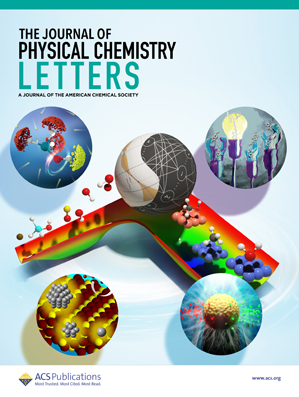Correction to “The Melamine-Driven Solvation Effect Promotes Oxygen Reduction on Platinum Catalyst: Machine Learning-Aided Free Energy Calculations”
IF 4.8
2区 化学
Q2 CHEMISTRY, PHYSICAL
引用次数: 0
Abstract
In our original manuscript, we inadvertently used base-10 logarithms instead of natural logarithms in implementing eqs (S32) and (S33) of the Supporting Information, which are used to calculate the vibrational quantum correction for the hydrogen atom bonded to water. This error resulted in an overestimation of the free energy of the hydrogen atom by approximately 60 meV, thereby lowering the redox potential UOH associated with OH adsorption on Pt catalysts both with and without melamine, as well as on various Pt alloys by 60 mV, shown in Figure 3 (a). A corrected version of Figure 3 (a), along with updated vibrational quantum correction values in Table S3 of the Supporting Information, is provided below. Since the evaluation of catalytic activity in our study relied on relative differences in UOH among the Pt catalysts, this uniform shift in absolute values does not alter the other results presented. Consequently, the main conclusions of the study remain unaffected. Nonetheless, the corrected absolute value of UOH, for instance, on Pt(111) increases from 0.40 to 0.46 V vs SHE, bringing it closer to the experimental reference value of 0.6 V vs SHE in ref. [14] of the original manuscript. Figure 3. (a) Redox potentials versus SHE for reaction 5 on Pt(111), Pt(111) with melamine, Pt/Pt2Cu/Pt(111), Pt/PtCu2/Pt(111), and Pt/Cu/Pt(111) surfaces obtained from TI calculations. The units of free energy and vibrational frequencies are eV and cm–1, respectively. Corrected values are indicated in bold. This article has not yet been cited by other publications.

更正“三聚氰胺驱动的溶剂化效应促进铂催化剂上的氧还原:机器学习辅助的自由能计算”
在我们的原稿中,我们无意中使用了以10为基数的对数而不是自然对数来实现支持信息的公式(S32)和(S33),这些公式用于计算氢原子与水结合的振动量子修正。这个误差导致氢原子的自由能高估了大约60 meV,从而降低了UOH在含和不含三聚氰胺的Pt催化剂以及各种Pt合金上OH吸附的氧化还原电位60 mV,如图3 (a)所示。下面提供了图3 (A)的更正版本,以及支持信息表S3中更新的振动量子校正值。由于我们研究中对催化活性的评估依赖于Pt催化剂中UOH的相对差异,因此这种绝对值的均匀变化不会改变所提出的其他结果。因此,研究的主要结论不受影响。尽管如此,以Pt(111)为例,修正后的UOH绝对值从0.40 V vs SHE增加到0.46 V vs SHE,使其更接近原始手稿参考文献[14]中0.6 V vs SHE的实验参考值。图3。(a)在Pt(111)、Pt(111)与三聚氰胺、Pt/Pt2Cu/Pt(111)、Pt/PtCu2/Pt(111)、Pt/Cu/Pt(111)和Pt/Cu/Pt(111)表面上反应5的氧化还原电位与SHE的对比。自由能和振动频率的单位分别为eV和cm-1。更正值以粗体显示。这篇文章尚未被其他出版物引用。
本文章由计算机程序翻译,如有差异,请以英文原文为准。
求助全文
约1分钟内获得全文
求助全文
来源期刊

The Journal of Physical Chemistry Letters
CHEMISTRY, PHYSICAL-NANOSCIENCE & NANOTECHNOLOGY
CiteScore
9.60
自引率
7.00%
发文量
1519
审稿时长
1.6 months
期刊介绍:
The Journal of Physical Chemistry (JPC) Letters is devoted to reporting new and original experimental and theoretical basic research of interest to physical chemists, biophysical chemists, chemical physicists, physicists, material scientists, and engineers. An important criterion for acceptance is that the paper reports a significant scientific advance and/or physical insight such that rapid publication is essential. Two issues of JPC Letters are published each month.
 求助内容:
求助内容: 应助结果提醒方式:
应助结果提醒方式:


